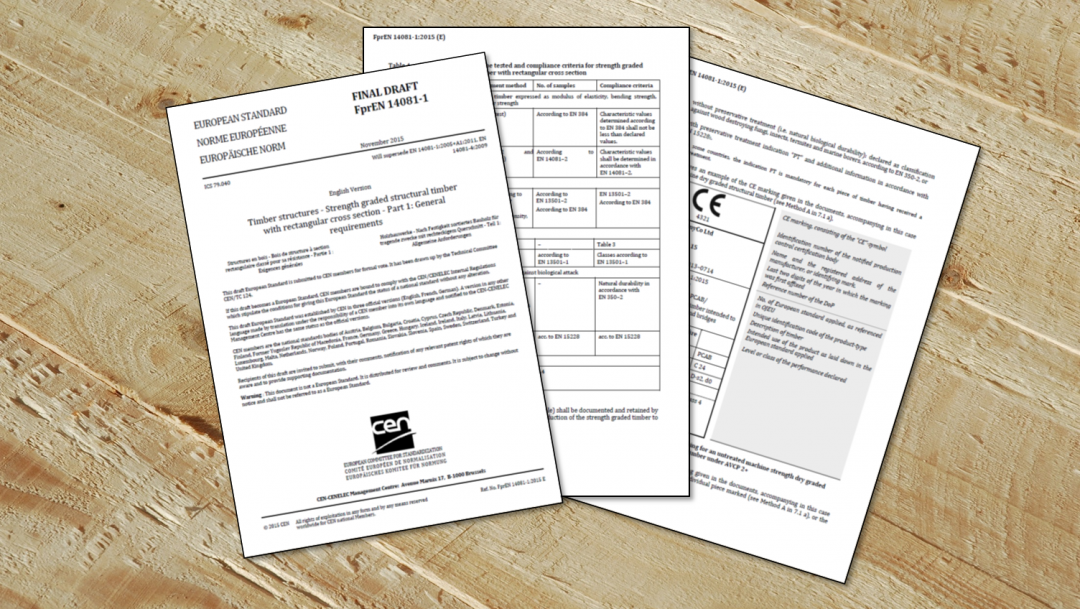
The UK has a long history of marking graded timber with a stamp – so that there is no risk of graded timber being misidentified and enabling the installed timber to be inspected to check the correct grade has been used. This is customarily known as a “grade stamp” but in the language of the European Standards it is a “marking”. It is not the same as the CE marking (see below).
Clause 7 of EN14081-1:2016 allows marking by two methods:
a) Method A – Individual piece marking:
Each piece of graded structural timber shall be clearly and indelibly marked
b) Method B – package marking:
Each package of graded structural timber shall be clearly and indelibly marked with a label attached to the package
Machine graded timber has to be piece marked (method A) but visual graded timber may be piece marked, or packaged marked (either method A or B).
In either case, the mark must contain the following:
- Manufacturer name/logo
- Declaration of Performance (DoP) reference/number (an identification code)
- Strength Class (or equivalent information about its performance)
- “DG” (or alternative marking meaning the same) when the timber has been Dry-Graded
- “M” when the timber has been Machine Graded
- CE ‘symbol’
Extra information may also be provided on the grade stamp, so long as it does not conflict with the required information. Examples of other information that may be provided in the stamp are:
- the number or logo of the Notified Body
- the visual grade of the timber and the grading rule/standard
- the wood species or species combination by code or botanical name
Some countries require preservative treated timber to be marked with the symbol “PT” (regardless of it being marked by method A or B) so that this is traceable for reuse and recycling. This is not a requirement in the UK (it is not considered practical as the timber is commonly treated after being stacked).
The option of method B was included to satisfy smaller producers in some countries that did not want the expense of stamping the timber. Initially this was proposed to be limited to cases where there was little risk of the timber being misidentified – going straight from the grader to a specific customer and specific construction – but it later got widened to a general option …the reasoning being that the CPR requires that the information about the timber to remain linked to the timber (somehow). BSI B/518 (the UK mirror committee of CEN/TC124/WG2) disagrees with such wide application of option of method B, and will provide some additional information, confirming the UK position with regard to ‘package marking’ in a National Annex to BSEN14081-1.
The partial factor in NA TO BS EN 1995-1-1:2004+A1:2008+A2:2012
the UK National Annex to BSEN1995-1-1 applies a specific partial factor to ‘solid timber grade stamp package marked’ for strength graded timber supplied in accordance with the ‘package marking’ option (method B). This partial factor significantly reduces the design strength of the timber and it is required because, notwithstanding the traceability requirement of the CPR, there is a risk of incorrect identification of unmarked timber.
More specifically, the UK NA to BSEN14081-1 will ask that the grade stamp must be stamped clearly and indelibly at least once on a face or edge and at least 600mm from the end of the piece. Grade stamped timber not meeting this requirement is to be regarded as being package marked (ie subject to the specific partial factor), owing to the possibility of the grade stamp being removed or hidden early during construction. (These conditions continue previous UK requirements on the grade stamp).
The only exception to the application of the partial factor for package marked timber is to be when the grade stamp is omitted for aesthetic reasons, and there is no significant risk of misidentification of the timber. Specifically, where visually strength-graded structural timber is requested to be supplied without grade stamps, for aesthetic reasons, then the timber may be marked according to method b (package marking). This is permitted only where a customer requests it for a single structure – and the timbers are exposed on completion (justifying the package marking on aesthetic grounds).
The CE marking and declaration of performance
EN14081-1:2016 defers to the CPR more than previous versions – since it is the CPR that lays down the requirements on CE marking and declaration of performance (governed by what is written in the Mandate – in this case M/112), and it is not the place of the EN to interpret them. The CPR, including its amendments, and delegated acts, is not an easy read. Indeed it is rather confusing in places. For example, the “CE marking”, strictly, refers to the CE symbol – which is why it asks for the CE marking to be followed by the information that we would regard, in normal language, as being part of the CE mark.
The CPR requires that the CE marking accompany every delivery to every customer. While the grade stamp includes the CE symbol, the required information falls short of that required for the CE marking. Ideally, the CE marking would be in the timber – but it is rather a long list. So, in addition to grade stamp, the CE marking must be affixed to the accompanying commercial documents (or the packaging of the timber), and this must go with the timber to its final recipient. (Note that the concept of partial and complete CE marking did not survive the editing of the standard – this is only one CE marking)
Important: This informal information is not a substitute for reading EN14081-1 and the Construction Products Regulation

Leave a Reply
You must be logged in to post a comment.